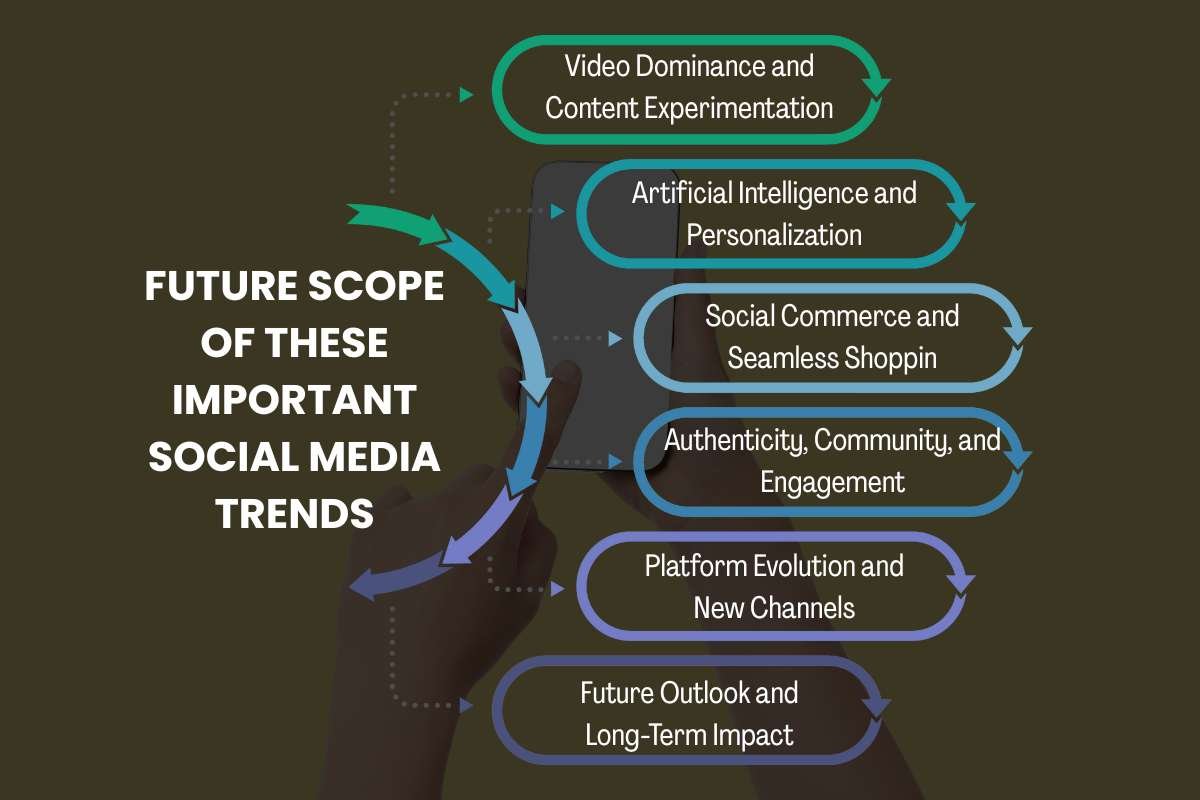Social media has evolved beyond its original purpose of creating social connections. Social media is now truly a global engine of enormous power, not just bringing together social stories around the globe, but even serving as a key driver of business development. Brands build their following based upon multiple factors, from sponsored ads to engaging stories to simply sharing information.
In an era of constantly changing digital influences, what separates one business from another in terms of success is the capability to tap into the spontaneous and strong currents of social media trends. What practical shifts detached from some sales are variables in behaviour, format, and mechanics. This quietly allows conversions, loyalty, and growth to continue measurably.
Unlocking the most important social media trends will shift the needle for your awareness and positioning buzz so that your brand is strong and stable in the digital marketplace. And it also excels and develops monetized value.
9 Most Important Social Media Trends in 2025 That Could Transform Your Marketing Strategy:
In 2025, social media is much more than just likes and shares. It is a thriving ecosystem where brands, creators, and audiences engage in new ways. From AI content creation to the emergence of niche platforms, marketers need to stay on top of the trends to forge genuine connections and drive business growth.
1. TikTok Leads the Pack
TikTok continues its meteoric rise, with over 2.5 billion users worldwide. Its powerful algorithm delivers hyper-personalized content, turning entertainment into a commerce powerhouse. Brands now see TikTok as a key channel for audience engagement, making it one of the most important social media trends today.
2. Social Media as the New Search Engine
Platforms like TikTok, Instagram, and YouTube are becoming the go-to destinations for product discovery. Social search optimization is essential, as consumers prefer finding answers directly within apps rather than traditional search engines. This shift is a core part of the most important social media trends of 2025.
3. AI-Powered Content Creation

AI tools now generate captions, videos, and visuals instantly, enabling brands to produce highly personalized content at scale. This boosts efficiency while allowing creative freedom, making AI a major driver in shaping the future of social media marketing.
4. Rise of Niche Platforms
Niche social networks are gaining traction, offering highly engaged communities around specific interests. These platforms allow brands to deliver tailored content and build deeper relationships, a growing facet of the most important social media trends.
5. Social Commerce Evolution
Social commerce is transforming the shopping experience by letting users discover and purchase products without leaving the platform. Advanced features like AR try-ons and live shopping events make this a must-watch trend for brands in 2025.
6. Influencer Marketing Matures

Influencer marketing is moving toward authentic collaborations with micro and nano influencers. These creators offer genuine engagement and trusted voices, making influencer partnerships a key strategy for brands.
7. Employee-Generated Content
More brands are empowering employees to create content, adding authenticity and a human touch. Employee advocacy is becoming a powerful marketing approach, building trust and connecting audiences to a brand’s story.
8. Cultural Fluency is a Must
Brands must adapt to global and local cultural trends to stay relevant. Culturally fluent campaigns help brands engage meaningfully, making this an essential element of the most important social media trends.
9. Social Listening Drives Strategy

Social listening tools give brands real-time insights into audience sentiment. This helps marketers respond faster, adapt strategies, and innovate, making social listening a game-changer in the social media world.
Future Scope of These Important Social Media Trends:
Rapid technological innovation and changes in user preferences define the future of social media trends, which are shaping the nature of engagement between individuals and between businesses and users. Major trends such as video-first, AI-driven personalization, social commerce, authenticity, and engagement with community will reshape the ecosystem in 2025 and beyond.

Video Dominance and Content Experimentation
- Short-form video will continue to be the most engaging format, especially on platforms like TikTok, Instagram Reels, and YouTube Shorts.
- Long-form video is re-surging, with platforms increasing maximum video lengths to attract deeper engagement and creative storytelling.
- Brands that experiment and repurpose video content across platforms will be best positioned to capture audience attention.
Artificial Intelligence and Personalization
- AI in social media is evolving from a content creation tool to a full-fledged team member, enabling hyper-personalized experiences, automated posts, and even creative ideation.
- Marketers will increasingly leverage AI for predictive analytics, optimizing campaigns, and efficient content workflows.
Social Commerce and Seamless Shopping
- Social platforms are increasingly integrating e-commerce features, making direct shopping, live sales, and influencer-driven purchases easier for users.
- This shift blurs the boundaries between social media engagement and online shopping, accelerating sales funnels and enhancing ROI tracking.
Authenticity, Community, and Engagement
- The demand for brand authenticity is rising, with more candid, unscripted, and behind-the-scenes content favored by audiences tired of polished perfection.
- Community-driven growth, transparent communication about brand values (such as sustainability and social consciousness), and two-way engagement are central strategies for building loyalty.
Platform Evolution and New Channels
- The proliferation of niche and interest-based platforms challenges mainstream social media, driving greater personalization and competition for attention.
- Platforms are evolving functionality to become social search engines, discovery tools, and interactive entertainment hubs—making social media central to digital life.
Future Outlook and Long-Term Impact
- In 2026 and beyond, expect AI to be fully mainstream, empowering faster, scalable content production and more granular audience targeting.
- Ultra-short video formats, local and geo-targeted campaigns, and playful brand personas will become more prevalent as attention spans shrink.
- Social media’s integration with commerce, search, and entertainment will deepen, making it indispensable for marketing, customer service, and public discourse.
Conclusion:
Adopting the Most Important Social Media Trends is about more than just jumping on the latest passing trend. It is about taking a strategic leap into the future of your business! From the algorithmic advantage of TikTok and the utility of AI-Powered Content to the authenticity of Employee-Generated Content and the actionable data from Social Listening, these nine trends are fundamentally changing how brands build trust, sell products, and cultivate audiences of global citizens.
By combining these trends, especially the continued prominence of short video format, the maturation of social commerce, and the pressure to be authentic. You also position your brand for durability and relevance and to turn every scroll into sustainable and accountable growth well into 2026 and beyond!
FAQ:
1. How is AI changing social media trends?
AI is revolutionizing social media by enabling brands to create personalized content at scale, predict audience preferences, and optimize posting strategies. Tools powered by generative AI now help brands create captions, visuals, videos, and even interactive content faster and more effectively, making AI one of the most impactful trends in social media marketing.
2. How can brands stay ahead of social media trends?
To stay ahead, brands must embrace innovation, monitor emerging platforms, and invest in strategies that align with evolving audience behavior. This includes leveraging AI for content creation, tapping into niche communities, prioritizing cultural relevance, and integrating shopping experiences directly within social channels.
3. How does employee-generated content influence social media strategies?
Employee-generated content adds authenticity and human connection, giving audiences a behind-the-scenes view of a brand. It strengthens trust and engagement, making it one of the fastest-growing strategies in modern social media marketing.


















